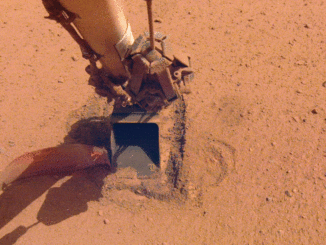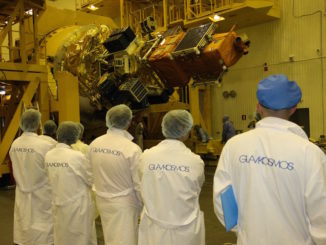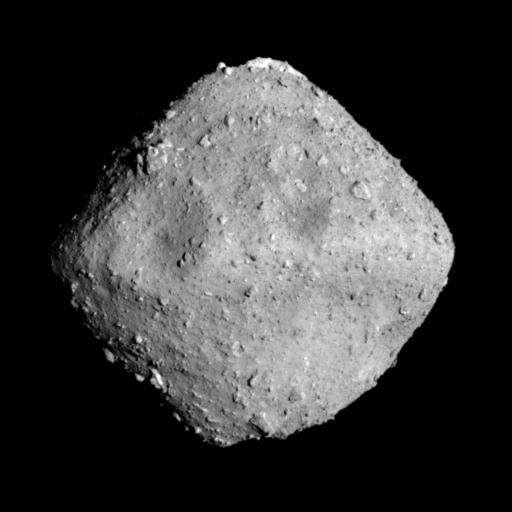
Japan’s robotic Hayabusa 2 spacecraft arrived Wednesday at asteroid Ryugu, a diamond-shaped object more than a half-mile wide where the probe will attempt a brief landing later this year to collect rock specimens for return to Earth.
After creeping up to the asteroid at an ever-slowing pace, thrusters on the Hayabusa 2 spacecraft stopped its approach Wednesday at a distance of about 12 miles, or 20 kilometers, according to the Japan Aerospace Exploration Agency.
The milestone marked the conclusion of a three-and-a-half-year voyage spanning nearly 2 billion miles (3.2 billion kilometers) since Hayabusa 2’s launch from southern Japan on an H-2A rocket in December 2014.
The space probe and asteroid Ryugu, seen up-close for the first time, are currently located roughly 177 million miles (285 million kilometers) from Earth. Under remote control from engineers and scientists in Japan, Hayabusa 2 will spend the next few weeks surveying Ryugu, moving closer in a sequence of maneuvers to obtain higher-resolution imagery and data on the asteroid’s gravity field.
“The shape of Ryugu is now revealed,” wrote Yuichi Tsuda, Hayabusa 2’s project manager at JAXA. “From a distance, Ryugu initially appeared round, then gradually turned into a square before becoming a beautiful shape similar to fluorite [known as the ‘firefly stone’ in Japanese].
“Now, craters are visible, rocks are visible and the geographical features are seen to vary from place to place,” Tsuda wrote. “This form of Ryugu is scientifically surprising and also poses a few engineering challenges.”
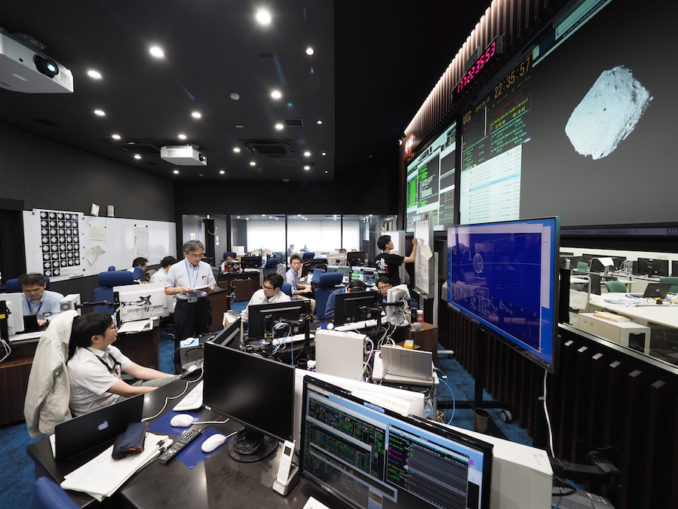
Hayabusa 2 will try to capture at least a gram of rock samples from Ryugu on three touch-and-go landing attempts, beginning as soon as early October. In late 2019, the spacecraft will depart the asteroid and head for Earth, dropping its sample-carrying re-entry canister for a parachute-assisted landing in South Australia in December 2020.
Scientists said Ryugu’s rotation is perpendicular to its orbit, which is good news for plans later this year to deploy a series of landers and tiny rovers on the asteroid, beginning with the deployment in October of the 10-pound (22-kilogram) MASCOT vehicle developed by German and French engineers.
The asteroid completes one rotation every 7.6 hours, and its orbit takes it around the sun once every 1.3 years. Ryugu’s orbit crosses the path of Earth around the sun, making it a potentially hazardous asteroid.
“On the other hand, there is a peak in the vicinity of the equator and a number of large craters, which makes the selection of the landing points both interesting and difficult,” Tsuda wrote.
The shape of Ryugu also suggests it may have an uneven gravity field, which is estimated to be around 60,000 times weaker than Earth’s, according to Tsuda.
“The project team is fascinated by the appearance of Ryugu and morale is rising at the prospect of this challenge,” Tsuda wrote. “Together with all of you, we have become the first eyewitnesses to see asteroid Ryugu. I feel this amazing honor as we proceed with the mission operations.”
All of Hayabusa 2’s science instruments are functioning as designed. The sensors include a camera suite, a laser designed to measure topography, and a near-infrared spectrometer to study Ryugu’s composition.
“At the end of July we will approach to within 5 kilometers (3 miles) of the surface, so we will have much more detailed surface images,” said Makoto Yoshikawa, Hayabusa 2’s mission manager, in an interview with Spaceflight Now earlier this month. “Also, in August, we will measure the gravity of Ryugu, and in that case we will send the spacecraft down to 1 kilometer (about 3,300 feet) from the surface.”
After the initial survey, Japanese scientists will decide in August where to send Hayabusa 2 to collect the first of three samples from Ryugu.
Hayabusa 2 will not go into orbit around Ryugu. Instead, the probe will follow trajectories around the asteroid, similar to the way a rendezvousing spacecraft approaches the International Space Station.
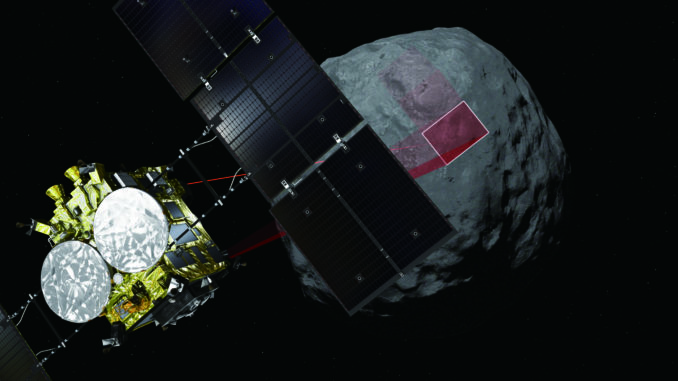
Since switching off its ion propulsion system in early June, Hayabusa employed hydrazine-fueled rocket thrusters to follow a zig-zag pattern toward Ryugu, taking range and bearing measurements to fine-tune its navigation to the asteroid. There was some uncertainty in the asteroid’s exact position before Hayabusa 2’s arrival.
The spacecraft’s telescopic camera also scanned for moons and other debris accompanying Ryugu, but found no evidence of any companions.
In an interview with BBC News on Wednesday, Yoshikawa said the sampling maneuvers will the be the riskiest part of the Hayabusa 2 mission.
“The most difficult part is getting the sample,” Yoshikawa told BBC News. “It is a little risky because we cannot operate from the Earth because there is a time delay, so the spacecraft must move by itself. The spacecraft has autonomous functions, but it’s very risky because the surface of Ryugu is not so smooth.”
We have three touchdowns (planned),” he said. “The first one is maybe in October. The second is maybe next year in February or March.
“So we have two chances, and actually one more,” he told BBC News. “Hayabusa 2 has an impactor which will create a small crater on the surface of the asteroid. If we can make a small crater, then the spacecraft will touch down at the crater to get subsurface material.”
Hayabusa 2 is one of two robotic asteroid missions arriving at distant objects this year. NASA’s OSIRIS-REx spacecraft, which launched in September 2016, is scheduled to arrive at asteroid Bennu on Dec. 3 to collect its own samples to bring back to Earth.
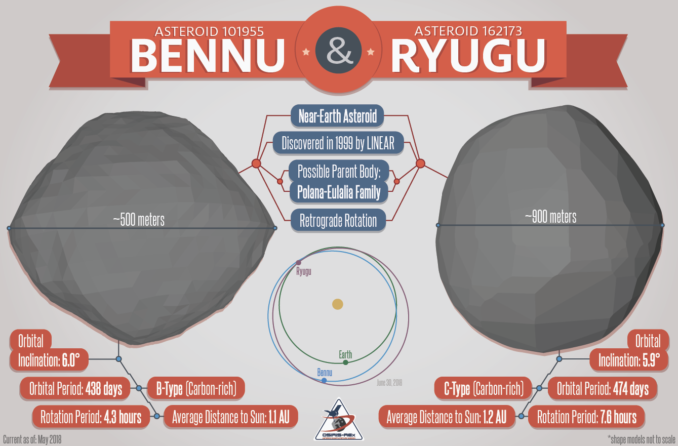
Hayabusa 2 is a follow-up to Japan’s Hayabusa mission, which collected less than a milligram of sample from the stony S-type asteroid Itokawa in 2005 and returned the material to Earth in 2010. But Hayabusa ran into numerous difficulties, including a fuel leak and a malfunction in its sampling mechanism, causing it to collect much less material than originally planned.
“Hayabusa was a technological demonstrator, so its main purpose was technology and the second purpose is science,” Yoshikawa said in an interview with Spaceflight Now. “For Hayabusa 2, science is the main purpose. That’s the big difference.”
Ryugu is a primitive C-type asteroid that contains organic materials scientists believe are leftovers from the birth of the solar system.
“For both missions, we wanted to learn about the origins of the solar system, but for Hayabusa 2, we want to understand the organic matter and water at the beginning of the solar system,” Yoshikawa said. “This is the major point for science.”
Email the author.
Follow Stephen Clark on Twitter: @StephenClark1.

